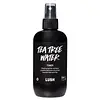What's inside
What's inside
 Key Ingredients
Key Ingredients

 Benefits
Benefits

 Concerns
Concerns

 Ingredients Side-by-side
Ingredients Side-by-side

Water
Skin ConditioningAlcohol Denat.
AntimicrobialTapioca Starch
PEG-40 Hydrogenated Castor Oil
EmulsifyingHamamelis Virginiana Water
AstringentPhenoxyethanol
PreservativeCaprylyl Glycol
EmollientGlycerin
HumectantMelaleuca Alternifolia Leaf Oil
AntioxidantAlcohol
AntimicrobialAllantoin
Skin ConditioningCalophyllum Inophyllum Seed Oil
AntimicrobialSalicylic Acid
MaskingTrisodium Ethylenediamine Disuccinate
Sodium Hydroxide
BufferingPolymethylsilsesquioxane
Limonene
PerfumingCitral
PerfumingLinalool
PerfumingLeptospermum Petersonii Oil
MaskingTocopherol
AntioxidantCI 19140
Cosmetic ColorantCaramel
Cosmetic ColorantCI 42090
Cosmetic ColorantWater, Alcohol Denat., Tapioca Starch, PEG-40 Hydrogenated Castor Oil, Hamamelis Virginiana Water, Phenoxyethanol, Caprylyl Glycol, Glycerin, Melaleuca Alternifolia Leaf Oil, Alcohol, Allantoin, Calophyllum Inophyllum Seed Oil, Salicylic Acid, Trisodium Ethylenediamine Disuccinate, Sodium Hydroxide, Polymethylsilsesquioxane, Limonene, Citral, Linalool, Leptospermum Petersonii Oil, Tocopherol, CI 19140, Caramel, CI 42090
 Reviews
Reviews

Ingredients Explained
These ingredients are found in both products.
Ingredients higher up in an ingredient list are typically present in a larger amount.
Limonene is a fragrance that adds scent and taste to a formulation.
It's found in the peel oil of citrus fruits and other plants such as lavender and eucalyptus. The scent of limonene is generally described as "sweet citrus".
Limonene acts as an antioxidant, meaning it helps neutralize free radicals.
When exposed to air, oxidized limonene may sensitize the skin. Because of this, limonene is often avoided by people with sensitive skin.
The term 'fragrance' is not regulated in many countries. In many cases, it is up to the brand to define this term. For instance, many brands choose to label themselves as "fragrance-free" because they are not using synthetic fragrances. However, their products may still contain ingredients such as essential oils that are considered a fragrance.
Learn more about LimoneneThis tea tree oil comes from the leaves of the Tea Tree plant. Tea tree oil has antioxidant, anti-inflammatory, and antimicrobial properties.
According to the book Journal of Profiles of Drug Substances, tea tree helps in reducing acne-causing bacteria such as Propionibacterium acnes. This is due to the Terpinen components of tea tree oil.
Tea tree may cause sensitivity and irritation for some people. This oil naturally contains fragrance such as linalool and limonene.
However, research shows irritation usually occurs when using pure tea tree oil and not in cosmetic products.
Tea tree oil was found to help relieve the symptoms of psoriasis in one study.
Tea tree oil is toxic when ingested. Another study showed it to caused damage to the nervous system of dogs and cats when applied to their skin or given orally.
Learn more about Melaleuca Alternifolia Leaf OilWater. It's the most common cosmetic ingredient of all. You'll usually see it at the top of ingredient lists, meaning that it makes up the largest part of the product.
So why is it so popular? Water most often acts as a solvent - this means that it helps dissolve other ingredients into the formulation.
You'll also recognize water as that liquid we all need to stay alive. If you see this, drink a glass of water. Stay hydrated!
Learn more about Water